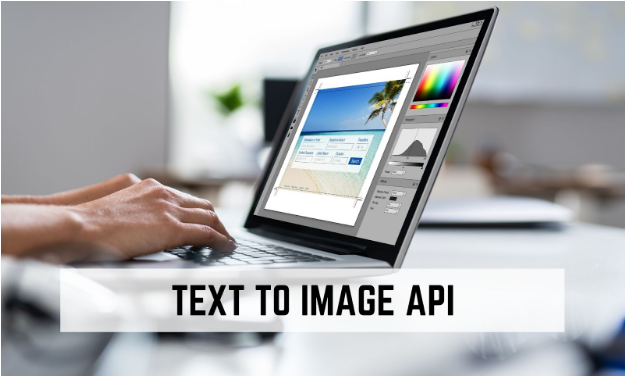22 Nov

|
Getting your Trinity Audio player ready...
|
Graphic design is pretty much essential to any effective marketing campaign or brand management effort, but it can be a time-consuming and, in effect, expensive part of the process.
This is especially true when you do not have the skills or the resources needed to create engaging visuals for your campaigns. Small to medium companies might not have the benefit of a skilled or dedicated graphic designer, while bigger companies may or may not have a structure that scales in proportion to their business.
This is why the world’s leading businesses have started using, if not developing their APIs to run their business. By sharing their data, improving their workflow, and automating repetitive tasks, businesses cannot only expand their services but also allocate time towards more impactful steps to grow their business.
In this article, we will discuss how text to image API can aid your graphic design workflow, especially if you’re a content marketer or a social media manager.
But first…
Table of Contents
What is Text To Image API?
API is short for application programming interface, but that can be too technical or complex for most, and that’s okay.
In simpler terms, API is code that allows two applications or pieces of software to ‘interface;’ that is, to communicate with one another in many efficient, secure, and specific ways.
You might not know it, but you’ve likely already experienced APIs in action—if you’ve used your Facebook account to log in to other sites or services (that are not Facebook), that’s thanks to an API. That’s only a small picture of what APIs can do as well; other popular examples of API that one might unknowingly be using include:
1. Weather data
Almost every smart device nowadays can show you the weather, which is made possible by using the API of credible weather services to gather and present this data to the end-user.
2. Map data
Google is a prime example of this, as many locations or transport-based applications such as delivery services use maps to pinpoint specific locations, whether static or moving, or in getting directions from two points.
3. Payment services
Similar to login features provided by Facebook/Google, banks or online payment platforms make their API available to various storefronts, so users can make secure payments directly on the shop, while the APIs handle the rest.
4. Travel and accommodation services
Booking services rely heavily on API to aggregate information on available flights or rooms across various airlines and hotels, so users spend less time searching the web for options.
5. eCommerce
Online shops, apart from payment APIs, also rely on making their inventory or database available to customers to browse and select items to buy. This is not far from the concept of data aggregation used by travel booking services, which involves retrieving information from a database and presenting it to the end-user in a format that they can understand.
Most applications or services use combinations of APIs that work together to help their business run as securely and as efficiently as possible, for far less effort than it would take to build their service from scratch.
Apart from using APIs, companies can also develop their API, whether it’s for internal or commercial use. Private APIs are often used to bridge multiple, interdependent functions of an organization, while some are shared with business partners, so that both may share features or services that would otherwise not be accessible to the individual business without much effort or cost.
Some companies also offer their APIs to the public, with or without cost, as a way to foster innovation or to increase their brand recognition by having the public adopt the use of their data or services, as they allow.
How does it work?
Think of the API as a messenger, relaying messages between two parties.
These messages can be either of two things: requests or responses. Just like in marketing, visuals help get our message across, so let’s paint a picture of how an API works.
Imagine you’re in a department store and want to buy some shoes, but none of the ones on display match your size. This is where the salesperson that just approached you comes in – he/she acts as the API who can take your shoe size and search the store’s inventory to see if they have a pair that fits you. Their value lies in their ability as an employee of the store to search the inventory, which likely isn’t something you are allowed to do yourself.
A better example of this is when your size, turns out, isn’t available at the store; the employee can then call up nearby branches for you and ask if they carry the shoe you want, in the size you want, then have it delivered to you. You are one “application” making a request, and the store with its inventory is the other application that provides the response. The salesperson helping you is the API.
This also illustrates an important aspect of the API: security
Regardless of how much of your life you share with the salesperson while browsing the store, the only data he/she needs and will use to get you a pair of shoes is your shoe size. The store’s inventory is also protected because you as a customer won’t be able to simply walk in and take whatever pair you want. By default, an API is secure because it prevents both applications from accessing information that is not relevant to their transaction. This is usually achieved by including authorization credentials or limiting access.
Another often-used example is the restaurant setting
You cannot simply walk into their kitchen and make yourself the meal you want; instead, you can only choose from the menu options available, and the waiter is responsible for relaying the specifics of your order for the kitchen to make, after which the waiter can serve your food.
APIs work in the same manner
The service provider has specifications on the kind of data and output it supports (the menu) and the API (your waiter) is designed to expect said data while knowing how to make the request (your order) and deliver the response (your prepared order.)
What is text to image API?
As a marketer, the best use of your time would be in coming up with engaging messages and publishing these to attract more business. This is where the text to image API comes in.
While this type of API can be designed to serve many different functions, the fundamental feature lies in the name; text data is used to work with or generate images. Some of the most common ways that text to image API can be used to your advantage include but are not limited to the following:
- An automated banner generation or automated image labeling – taking your text input and embedding it onto a selected image file. Some services like Pixelixe, on top of its built-in editor, allow users to generate marketing visuals in bulk using a single design, saving editors plenty of time editing and exporting for the same.
- Image optimization – compressing or decompressing images, converting files types or better web performance, etc. Some social sites also impose character limits which can restrict your messaging; turning text into images provides more room to convey more information in a single post, making it more effective as a marketing tool.
- Security – converting text to images to prevent them from being read by bots or used as keywords for online attacks.
The overall goal is to reduce time spent on repetitive tasks and manual work so that marketers have more time for true creative tasks and ensure that the brand and message are conveyed in the best possible manner.
Importance of creative automation using API
So, why use API in your graphic design process?
1. It makes the graphic design more accessible for everyone
With API automation, graphic design stops being a bottleneck in the process and makes it more approachable to a wider variety of users as a whole. The task can now be done by other members of your team whether or not they have a background in graphic editing and designing.
2. You can scale faster if you automate
It also allows for faster and more scalable production cycles, allowing companies to expand their reach with far less effort than it would take to manually familiarize themselves with new audiences, platforms, and technology.
3. Your creative output is consistent
Investing in creative automation also ensures a greater deal of consistency.
Templates, settings, and parameters ensure that your brand identity is preserved and recognized especially when your business begins to grow. This also creates advantages for localized campaigns, for example, as text elements can be translated without having to repeat work on elements that don’t need to change.
4. It will make your social media campaigns easier
Images from automated banner generation tools will help those writing articles break up sections with interesting yet informative visuals. On the other hand, store owners or marketers can use automated image labeling tools to create uniform and attractive product images to draw more buyers to their shop. Automated export tools make it such that the process of ensuring compatibility with a wide range of platforms need not be too tedious.
5. Automating early will save you time and resources
While time and effort do need to be invested in setting up a text to image API, the good choices come with documentation that should make it a breeze to use. Outside of any need to update the API setup, this is a one-time ordeal that translates into huge potential time savings when it comes time to create the visual assets for your future marketing campaigns. The good news is, more and more tools are making this set-up easier even if you are not a graphic designer.
This is why setting up some form of creative automation should be started as early as possible. By investing the time and effort in adopting API as early as now, you can spend much less time on the graphic design process and focus on what you do best: publishing material, engaging your audience, and growing your business as a whole.
Takeaway
Graphic design does not need to be intimidating or tedious when it comes to the overall marketing workflow. Text to image API can be a powerful tool to aid your business, especially if you lack excellent graphic design resources, lack the time, or don’t possess the technical skills necessary for graphic design yourself.
As the API market continues to grow, you are more than likely to find a combination from the tens of thousands of APIs available that allows you to simplify and automate most, if not all, of your workflow.
Start using API today, so you can focus on what matters most in the long run.
Author’s Bio:
Shelly Solis is a digital marketing and blog outreach specialist. She has been an online content writer since 2009 and has a decade of experience in digital marketing. She is one of the women behind SaaSLaunchr, a newly-launched digital marketing agency focused on SaaS SEO, guest posting, and content marketing.


